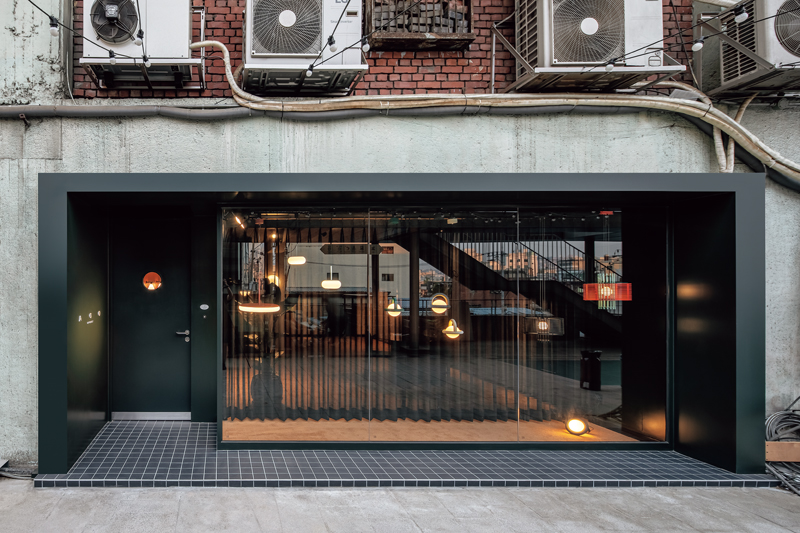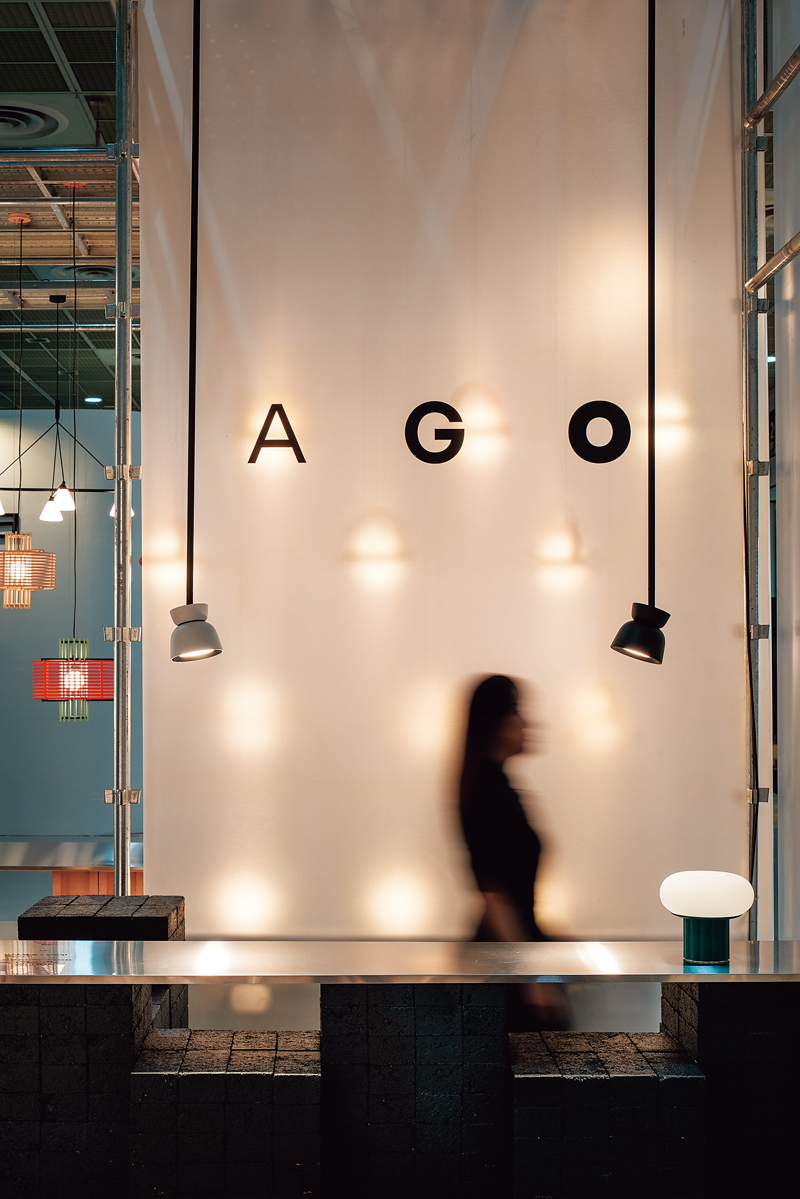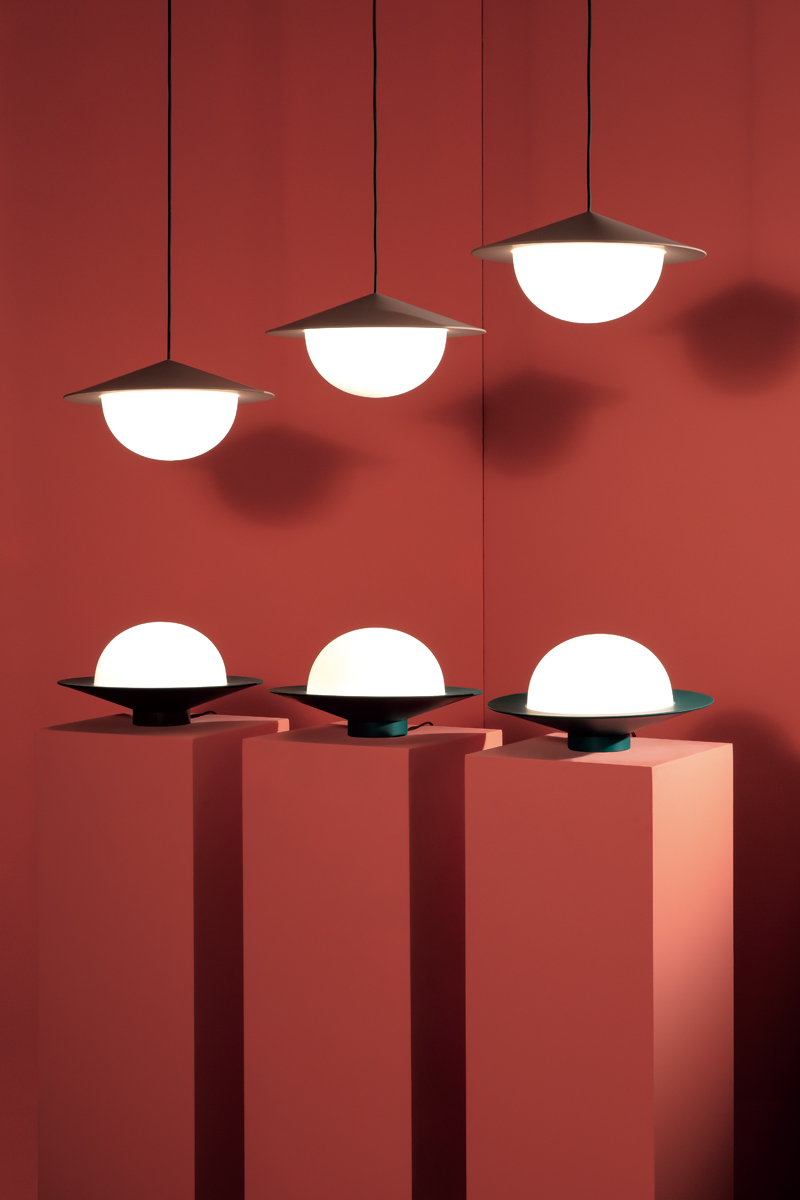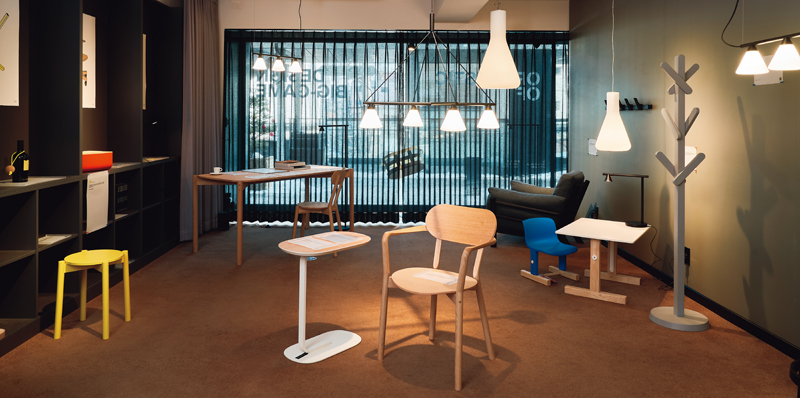Lighting brand AGO, launched in 2019, has breathed new life into the previously lackluster Korean lighting industry thanks to its simple yet sophisticated and original designs. This success came through collaboration be
tween business owners and designers, made possible by the inimitable industrial ecosystem of Seoul’s Euljiro area.

A glimpse into AGO’s showroom on the 3rd floor of Daelim Plaza in Euljiro. Founded by Woobok Lee a lighting distributor with 30 years of experience, and Stockholm-based designer Mars Hwasung Yoo, AGO made its debut in 2019 at Maison&Objet.
Courtesy of Studioflock; Photo by texture on texture
The Seoul Future Heritage initiative, launched in 2013 by the Seoul Metropolitan Government, aims to preserve and promote yet-to-be-designated tangible and intangible heritage from the city’s modern and contemporary past. One of these assets is the Euljiro Lighting Street, located between the Euljiro 3-ga and 4-ga subway stations. Designated as future heritage in 2016, the street is home to a cluster of around 200 lighting stores, many of which have been in business for over 30 years. Alongside furniture, hardware, machinery, sewing, printing, sculpture, and tiles, lighting constitutes one of Euljiro’s specialized industries. Emerging in the 1960s, the industry experienced its heyday in the 1970s and 1980s. Thereafter, the boom in the development of satellite cities around the capital in the early 1990s led to a rapid increase in the construction of apartment buildings and multi-family homes, driving up the demand for lighting fixtures and sustaining the industry’s momentum. Afterwards, a burgeoning interest in interior design prompted many people to visit Euljiro in search of lighting products and other items to decorate their homes. Out of this decades-old industrial ecosystem came lighting brand AGO, which has garnered praise for setting new standards for the Korean lighting industry.
LIGHT AT THE END OF THE TUNNEL
Euljiro’s lighting industry has historically played a central role in the city’s industrial sector, but it has also been plagued by the circulation of counterfeit products. Over the years, the landscape of the Euljiro lighting market has changed drastically, partly due to the online availability of low-cost foreign products, but also because consumers have developed higher aesthetic standards and increasingly shun counterfeit goods. In order to retain clients, merchants responded by elevating their overall service and product quality and established the Korean Lighting Distribution Cooperative and the collective brand ALLUX.
The city government took its own measures to preserve the unique character of the Lighting Street while also paving the way for its revitalization. For its first initiative, the Jung District Office partnered up with the Seoul Design Foundation to jointly organize the Euljiro, Light Way event, which was first held in 2015. With a diverse program featuring lighting exhibitions, live performances, and guided tours of the area, the event focused on promoting the Euljiro lighting industry to the public.
In 2017, these partners went one step further and launched By Euljiro, a project to unite lighting companies and designers in Euljiro under a single brand. The following year, products from three of the eight participating teams were showcased at Maison&Objet in Paris, Europe’s largest interior design fair. The project continued in 2018 and 2019 with eleven and ten teams, respectively, and was positively received on both occasions.
CEO Woobok Lee of Modern Lighting, a distributor of Euljiro lighting products with 30 years of experience, recognized the project’s potential to overcome the issue of counterfeit goods. Similarly drawn to the project was Mars Hwasung Yoo, the founder of Stockholm-based design studio BYMARS, who is known for his bold style and meticulous work ethic. “To be honest, I got behind the By Euljiro project because I wanted to express my concern over the widespread circulation of counterfeit goods in Euljiro and find a way to resolve this issue with the other parties involved,” Yoo said. Having crossed paths through the project in 2017, Lee proposed a collaboration with Mars to revitalize the Euljiro lighting industry. The two subsequently established the lighting brand AGO, named after the Korean word for “old friend.”

The AGO booth at the 2021 Seoul Living Design Fair. Built from reusable materials, the booth displayed a variety of the brand’s designs, including BALLOON, CIRKUS, and ALLEY, demonstrating its clear-cut identity.
ⓒAGO
CLEAR-CUT DESIGNS
Launched in 2019, AGO instantly set itself apart from other Korean lighting brands thanks to its products’ unique aesthetic appeal. With bold shapes, vibrant colors, and elegant curves, AGO’s designs brought a breath of fresh air to the domestic lighting market. Following its debut at the 2019 Maison&Objet fair, AGO went on to present its products at the 2020 Stockholm Furniture Fair. In the same year, AGO’s CIRKUS line won the “Best Dinner Guests” accolade at the Wallpaper* Design Awards, earning the brand international recognition for the innovative design and quality of its products.
With lamps that resemble glutinous rice cakes, futuristic designs reminiscent of spacecraft, and pendant lights with adjustable projection angles, AGO’s designers demonstrate that lighting can serve a purpose beyond simply illuminating a space. Yoo, who is also AGO’s art director, deserves great credit for this. His first responsibility at AGO was to seek out other designers with whom to collaborate and develop the brand’s design identity. Thanks to his efforts, AGO successfully teamed up with an illustrious group of designers, including Augustin Scott de Martinville, Elric Petit, and Grégoire Jeanmonod of Swiss-based design studio BIG-GAME; Swedish architect and designer Jonas Wagell; and German designer Sebastian Herkner, to name but a few.
AGO always strives toclear-cut designs. Two years of collaboration and discussion led to the completion of thirteen products adhering to this core principle. Euljiro’s industrial ecosystem played a key role in allowing the production of so many designs within this short time frame. In Euljiro, prototypes can be swiftly manufactured, evaluated by designers, and adjusted based on feedback in a seamless process that is easily repeated multiple times. This is thanks to the area’s abundance of industrial craftspeople who each specialize in a particular skill and use their expertise to offer tailored solutions to the designers.
At the same time, if AGO is to establish itself as a global brand, it cannot rely solely on Euljiro’s inimitable industrial landscape to enhance the quality of its products. Considering the work involved in the manufacture of design lighting, where products undergo multiple iterations using various materials and technologies before they are market-ready, CEO Lee, always a champion of domestic production, opted to team up with factories in other parts of the country. These included a factory in the Seoul area which is able to produce all necessary components for AGO’s products, as well as a factory in Paju, a city in Gyeonggi Province, which oversees the final assembly process. Designer Yoo stays in constant communication with all the crafts people, emphasizing the importance of attention to detail throughout the entire process to ensure his designs are executed flawlessly. While some of them initially did not think much of the strict standards he imposed, they soon witnessed firsthand the impact seemingly small details could have on the final product. This earned Yoo the nickname “0.1 mm.”

Born in Euljiro, lighting brand AGO has made a name for itself through its strong emphasis on design. ALLEY, shown here, was developed in collaboration with Swedish designer Jonas Wagell.
ⓒ AGO
CHANGING INDUSTRIAL ECOSYSTEM
Early on, the launch of a new lighting brand in Euljiro was met with a lukewarm response. Some people were skeptical whether AGO could really succeed given the prevalence of counterfeit products. There were also doubts about a specialized lighting brand’s appeal to domestic consumers, since the majority of Korean homes are move-in ready and come with pre-installed lighting. But the excellence of AGO’s locally made products helped solidify its presence on the market. The brand’s bold designs have been met more favorably than initially expected, and AGO products are regularly seen on the social media feeds of young people, particularly those with a keen interest in interior design.
AGO’s success has even led to the emergence of knockoffs, but Yoo isn’t particularly concerned about this trend. “People who buy replicas are less likely to buy the original anyway, and the same is true vice versa. The markets for counterfeit goods and originals are inherently distinct from each other.”
Since AGO’s launch, Euljiro has experienced a gradual transformation driven by individuals willing to break away from conventional practices and venture into uncharted territory. AGO has become a benchmark in the Korean lighting industry by demonstrating how a strong brand can be the key to nurturing a vibrant industrial ecosystem. Now in its fifth year, it has successfully established itself in Euljiro where it is collaborating with other brands across different industries to achieve its goal of becoming a global p in the lighting market.

AGO’s 2022 Optimistic Design exhibit featured several products from its PROBE collection designed by Swiss-based studio BIG-GAME.
ⓒ AGO